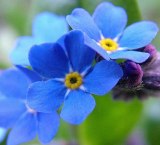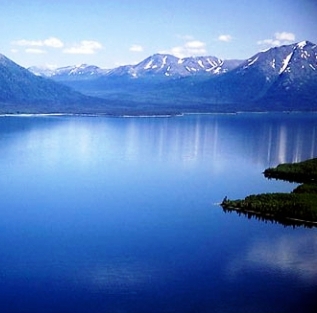Alaska has about 3,197 officially named natural lakes, out of over 3,000,000 unnamed natural lakes. 86,051 square miles of Alaska are covered by water. The largest, Lake Iliamna, encompasses over 1,000 square miles. Many of Alaska's lakes are only reachable by air or boat. Lakes that are easily accessible are used for recreation such as boating, fishing, and swimming.
Lake Clark is a lake in southern Alaska. It drains through Six Mile Lake and the Newhalen River into Iliamna Lake. Lake Clark is 42 miles long, 1056 feet deep, and covers 128 square miles. It's the sixth largest lake in Alaska. Nearby Lake Iliamna is the second largest lake that is entirely in the U.S., after Lake Michigan. Lake Clark was named for John W. Clark, chief of the Nushagak trading post in 1891 and the first American non-Native to see the lake. The Dena'ina Athabascan name is Qizjeh Vena which means "place where people gather lake"
Lake Clark National Park and Preserve straddles the Alaska Range in between Denali and Katmai National Parks and Preserves. Lake Clark National Park and Preserve boasts 123 miles of coast along Cook Inlet. The entire coast is located just west of the Kenai Peninsula, and includes parts of Tuxedni and Chinitna bays. Its dynamic landscape boasts active volcanoes and earthquake fault lines, glaciers, 130 miles of coastline, 6,000 miles of rivers, and protects numerous large lakes, including the park’s namesake Lake Clark, the sixth largest lake in Alaska.
Lake Clark National Park located 150 miles southwest of Anchorage is a great destination for those whose wish to avoid the crowds as it offers blissful solitude in the wilderness of Alaska. Visitors can enjoy diverse landscapes and wildlife. Established in 1980 to protect scenic beauty including volcanoes, glaciers, wild rivers and waterfalls, populations of fish and wildlife, watersheds essential for red salmon, and the traditional lifestyle of local residents, Lake Clark National Park and Preserve provides a true wilderness experience for those who visit.
The Telaquana Trail is not a trail in the modern sense, but an historic travel route, running from Telaquana Lake to the outlet of the Kijik River on Lake Clark. The route is a traditional Dena'ina Athabascan corridor connecting the Stony River/Mulchatna country to the Lake Clark area. Hiking parts of the route has become a popular recreation choice for visitors. The Telaquana Trail is an historic Dena'ina Athabascan route from Telaquana Lake to Kijik Village on Lake Clark. Early western explorers noted that the Inland Dena'ina were expert hikers, and trails connected all major villages in the area to each other and to seasonal camps. The Telaquana trail is part of a larger network crossing Dena'ina territory on the upper Alaska Peninsula.
The Lake Clark coast has a maritime subarctic climate. Over the mountains to the west, the park's interior climate is considered continental with cold winters and warm summers. Six remote weather stations located in and around Lake Clark are helping park scientists monitor climate.
Experience Alaska in one of the most beautiful areas of the state. Whether you are fishing, kayaking, hiking or river rafting, you'll enjoy Clark Lake while surrounded by majestic mountains and waterfalls, abundant wildlife and pristine waters. Clark Lake and the surrounding area is magnificent country! This area features some of the best sport fishing in the world as well as opportunities for viewing many of Alaska's big game species, including black and brown bear, moose and Dall sheep. Dall sheep are the only wild sheep in the world with a white coat. Because they prefer steep, mountainous habitat, spotting a sheep is a rare treat in Lake Clark National Park and Preserve.
The Kijik area (which includes Kijik Lake and the portion of the Kijik River that flows between the lake and Lake Clark) has been given some of the nation's highest designations of cultural importance. It is a National Historic Landmark and an Archeological District, one of only three areas in Alaska with both designations. Kijik is also a documented cultural landscape.
Kijik National Historic Landmark contains more than a dozen archeological sites, including a village abandoned at the beginning of the 20th century. The sites are affiliated with the inland Dena'ina Athabascan people who continue to live in the Lake Clark area. Continuously inhabited since early pre-historic times, the Lake Clark region nevertheless remains sparsely populated by humans.
|
|







